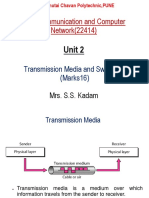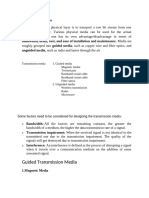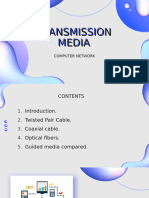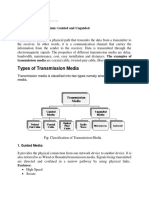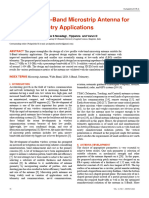0 ratings0% found this document useful (0 votes)
6 viewsLecture 4 - Transmission basics and networking media part 2
good for revision
Uploaded by
mungai.allanCopyright
© © All Rights Reserved
Available Formats
Download as PDF, TXT or read online on Scribd
0 ratings0% found this document useful (0 votes)
6 viewsLecture 4 - Transmission basics and networking media part 2
good for revision
Uploaded by
mungai.allanCopyright
© © All Rights Reserved
Available Formats
Download as PDF, TXT or read online on Scribd
You are on page 1/ 24
What is Communication
• Communication is the activity or process of exchanging
information in mutual understanding form.
• A computer system can be vast resource of
information. Once this system is connected to a
network, this information can be shared among all
other users.
• A communication media is required to connect
different computer systems to facilitate the
information exchange. Following diagram will give a
clear picture of different type of transmission media
Transmission
media
Guided Unguided
Twisted-Pair Coaxial Fiber-optic Terrestrial
Satellite Infrared
cable cable cable microwave
Figure 2.1 Types of transmission media
A. Guided Transmission Media
• Guided/physical/non-wireless/bounded media
have a physical link between sender and
receiver.
• Mainly there are three categories of guided
media:
1. Twisted-Pair,
2. Coaxial, and
3. Fiber-optic.
1. Twisted-Pair Cable
• A twisted consist of two conductors (usually copper), each with
its own colored plastic insulation. In the past, two parallel wires
were used for communication. However, electromagnetic
interference from devices such as a motor can create over noise
to those wires. If the two wires are parallel, the wire closest to
the source of the noise gets more interference than the wire
further away. Which results in an uneven load and a damaged
signal.
• If, how ever, the two wires are twisted around each other at a
regular intervals (between 2 to 12 twist per foot), each wire is
the closer to the noise source for half the time and the further
away the other half. With the twisting interference can be
equalized for both wires. Twisting does not always eliminate the
impact of noise, but does significantly reduce it
• Twisted cable comes in two forms: unshielded and shielded.
Twisted pair cable
a. Unshielded Twisted (UTP) cable
• UTP consists of a number of twisted pairs with
simple plastic casing. UTP is commonly used in
telephone system.
• The Electrical Industry Association (EIA) divides UTP
into different categories by quality grade. The rating
for each category refers to conductor size, electrical
characteristics, and twists per foot.
a. Unshielded Twisted (UTP) cable
• Category 1: Applies to transmit traditional UTP telephones cabling, which is
designed to carry voice but not data.
• Category 2: Certifies UTP cabling for bandwidth up to 4 Mbps and consists of four
pair of wires. Since 4 Mbps is slower than most networking technologies in the use
today. Category 2 is rarely encountered in networking environment.
• Category 3: Certifies UTP cabling for bandwidth up to 10Mbps. This includes most
conventional networking technologies, such as 10BaseT Ethernet and 4Mbps token
ring etc. Category 3 consists of four pairs, each having minimum 3 twist per foot.
• Category 4: Certifies UTP cabling for bandwidth up to 10Mbps. This includes
primarily 10BaseT Ethernet and 16Mbps token ring. Category 4 consists of four
pairs.
• Category 5: Used for data transmission up to 100Mbps Category 5 also consists of
four pairs.
• UTP is particularly prone to cross talk, and the shielding included with STP is
designed specifically to reduce this problem.
• Cat 5e
• Category 6: Category 6 cable, commonly referred to asCat 6, is a
standardized cable for Gigabit Ethernet and other network physical layers that is
backward compatible with the Category 5/5e and Category 3 cable standards.
Compared with Cat 5 and Cat 5e, Cat 6 features more stringent specifications for
crosstalk and system noise
b. Shielded twisted pair cable
b. Shielded Twisted (STP)
• STP includes shielding to reduce cross talk as well
as to limit the effects of external interference. For
most STP cables, this means that the wiring
includes a wire braid inside the cladding or sheath
material as well as a foil wrap around each
individual wire. This shield improves the cable's
transmission and interference characteristics,
which, in tern, support higher bandwidth over
longer distance than UTP.
2. Coaxial cable
• Coaxial Cable: Coaxial cable, commonly called
coax, has two conductors that share the same axis.
A solid copper wire runs down the center of the
cable, and this wire is surrounded by plastic foam
insulation. The foam is surrounded by a second
conductor, wire mesh tube, metallic foil, or both.
The wire mesh protects the wire from EMI. It is
often called the shield. A tough plastic jacket forms
the cover of the cable, providing protection and
insulation.
2. Coaxial cable cont...d
• Where Ethernet is concerned, there are two types of coaxial
cable, called this Ethernet (also known as thinnet or
thinwire,) and thick Ethernet (also known as thicknet or
thickwire). The Institute of Electrical and Electronics
Engineers (IEEE) designates these cable types as 10Base2 and
10Base5, respectively, where these notations indicates:
• Total bandwidth for the technology: in this case, 10 means
10Mbps
• Base: indicates that the network uses baseband signaling and
this applies to both types of cable.
• 2 or 5: a rough indicator of maximum segment length,
measured in hundreds of meters; thinwire support a
maximum segment length of 185 meters, which rounds up to
200; thickwire supports a maximum segment length of 500
meter.
3. Fiber Optic Cable
• Fiber optic cable transmits light signals rather than
electrical signals. It is enormously more efficient than
the other network transmission media. As soon as it
comes down in price (both in terms of the cable and
installation cost), fiber optic will be the choice for
network cabling.
• An optical transmission system has three components:
the transmission medium, the light source and the
detector. The transmission medium is an ultra-thin
fiber of glass or fused silica. The light source is either a
LED (Light Emit Diode) or a laser diode, both of which
emits light pulses when a electrical current is applied.
The detector is a photo diode, which generates an
electrical pulse when light falls on it.
Fiber optic cable
Fiber optic cont...d
• A cable may contain a single fiber, but often fibers are bundled
together in the center of the cable. Optical fiber are smaller and
lighter than copper wire. One optical fiber is approximately the same
diameter as a human hair.
Advantages of Fiber Optic
• Noise resistance: it is immune to EMI
• Less signal attenuation: signal can run for miles without requiring
regeneration
• Higher bandwidth: fiber optic cable can support dramatically higher
bandwidths (and hence data rate) than all other cables. Currently,
data rates and bandwidth utilization over fiber-optic cable are limited
not by the medium but by the signal generation and reception
technology available. A typical bandwidth for fiber optic is 100Mbps
to 1Gbps.
Disadvantages of Fiber Optic
• Cost : most expensive among all the cables
• Installation / maintenance: is high
• Fragility : glass fiber is more easily broken than wire
Summary Table of the Characteristic of All
Cable Type
Factor UTP STP Coaxial Fiber Optic
Cost Lowest Moderate Moderate Highest
Installation Easy Fairly easy Fairly easy Difficult
Bandwidth 10 Mbps 16 Mbps 10 Mbps 100 Mbps –
Capacity 1 Gbps
Node 2 2 30 (10Base2) 2
Capacity Per 100
Segment (10Base5)
Attenuation High High Lower Lowest
EMI Most Less Less No effect by
vulnerable to vulnerable vulnerable EMI
EMI than UTP than UTP
B. Unguided Transmission Media
• Unguided/non-physical/wireless/unbounded
media have no physical link between sender
and receiver.
1. Terrestrial Microwave
• Microwaves do not follow the curvature of the
earth therefore require line of sight transmission
and reception equipment.
• The distance coverable by line of sight signals
depends to a large extend on the height of the
antenna: the taller the antenna, the longer the
sight distance.
• Height allows the signals to travel farther without
being stopped by the curvature of the earth and
raises the signals above many surface obstacles,
such as low hills and tall buildings that would
otherwise block transmission.
1. Terrestrial Microwave cont...d
• Microwave signals propagate in one direction at a
time, which means that two frequencies are
necessary for two ways communication such as
telephone communication. One frequency is
reserved for transmission in one direction and
other for transmission in other. Each frequency
requires its own transmitter and receiver. Today,
both pieces of equipment usually are combined in
a single piece of equipment called transceiver,
which allows a single antenna to serve both
frequencies and functions.
Microwave Transmission
• Terrestrial microwave systems are typically
used when using cabling is very costly and
difficult to set.
2. Satellite Communication
• Satellite transmission is much like line of sight
microwave transmission in which one of the stations is
a satellite orbiting the earth.
• The principle is the same as terrestrial microwave, with
a satellite acting as a super-tall antenna and repeater.
• Although in satellite transmission, signals must still
travel in straight lines, the limitations imposed on
distance by the curvature of the earth are reduced. In
this way, satellite relays allow microwave signals to
span continents and ocean with a single bounce.
• Satellite microwave can provide transmission capability
to and from any location on earth, no mater how
remote
• This advantage makes high quality communication
available to undeveloped parts of the world
without requiring a huge investment in ground
based infrastructure.
• Satellite themselves are extremely expensive, of
course, but leasing time or frequencies on one can
be relatively cheap.
3. Infrared Transmission
• Infrared media uses infrared light to transmit
signals.
• LEDs transmit the signals, and photodiodes receive
the signals.
• The remote control we use for television, VCR and
CD player use infrared technology to send and
receive signals.
• Because infrared signals are in high frequency
range, they have good throughput. Infrared signals
do have a downside; the signals cannot penetrate
walls or other objects, and they are diluted by
strong light sources.
Summary Table of the Characteristic
of Wireless Communication Media
Factor Terrestrial Satellite Microwave Infrared
Microwave Transmission
Cost Moderate to high High Moderate to high
Installation About 1 to 10Mbps About 1 to 10Mbps 100Kps to 16Mbps
Bandwidth capacity About 1 to 10Mbps About 1 to 10Mbps 100Kbps to 16Mbps
Node capacity per 2 (sender and 2 (sender and 2 (sender and
segment receiver) receiver) receiver)
Attenuation Depends on Depends on Depends on
condition (affected condition (affected condition (affected
by atmospheric by atmospheric by atmospheric
conditions) conditions) conditions)
Security Depends on Depends on Depends on
condition (affected condition (affected condition (affected
by atmospheric by atmospheric by atmospheric
conditions) conditions) conditions)
Transmission Impairments
• The most significant impairments are the following:
Attenuation
• When an electromagnetic signal is transmitted
along any medium, it gradually become weaker at
greater distances, this is referred to as attenuation.
To solve this problem amplifier is used. The
amplifier boosts the signals and extends the
transmission distance.
Noise
• Random electrical signals that can be picked up by
the transmission medium and result in degradation
of the data.
You might also like
- 5.NETWORK TECHNOLOGY_3b2d0d22-bf5f-4586-80a7-388a8b1ae437No ratings yet5.NETWORK TECHNOLOGY_3b2d0d22-bf5f-4586-80a7-388a8b1ae43789 pages
- Lect 1 Network Technology Computer Science Ram Rai Sir NehaNo ratings yetLect 1 Network Technology Computer Science Ram Rai Sir Neha84 pages
- 02b Transmission Media and Their CharacteristicsNo ratings yet02b Transmission Media and Their Characteristics44 pages
- Technical Tips on Type of Communication Cable 1651249347No ratings yetTechnical Tips on Type of Communication Cable 16512493474 pages
- Unit 2: Transmission Media and Switching (Total Marks-14)No ratings yetUnit 2: Transmission Media and Switching (Total Marks-14)38 pages
- L1-2 Networking Devices Transmission mediaNo ratings yetL1-2 Networking Devices Transmission media41 pages
- Transmission Medium Guided Transmission Media Wireless TransmissionNo ratings yetTransmission Medium Guided Transmission Media Wireless Transmission24 pages
- Ambo University Woliso Campus, Technology and Informatics School Department of Computer ScienceNo ratings yetAmbo University Woliso Campus, Technology and Informatics School Department of Computer Science27 pages
- CISA Exam - Testing Concept-Network Physical Media (Fiber Optic/ UTP/STP/Co-axial) (Domain-4)From EverandCISA Exam - Testing Concept-Network Physical Media (Fiber Optic/ UTP/STP/Co-axial) (Domain-4)No ratings yet
- Design of Wide-Band Microstrip Antenna For S-BandNo ratings yetDesign of Wide-Band Microstrip Antenna For S-Band7 pages
- LTE KPI Introduction: Huawei Technologies Co., LTD100% (3)LTE KPI Introduction: Huawei Technologies Co., LTD48 pages
- List of Dramas Aired in Korea by Network in 2014 - DramaWikiNo ratings yetList of Dramas Aired in Korea by Network in 2014 - DramaWiki11 pages
- Basic Theory and Laboratory Experiments in Measurement and Instrumentation A Practice Oriented Guide Andrea Cataldo all chapter instant download100% (6)Basic Theory and Laboratory Experiments in Measurement and Instrumentation A Practice Oriented Guide Andrea Cataldo all chapter instant download55 pages
- Manual de Usuario Yaesu FT-270R (88 Páginas)No ratings yetManual de Usuario Yaesu FT-270R (88 Páginas)2 pages
- Dipit, The Revolutionary Dipmeter of The German QRP Club Dl-Qrp-AgNo ratings yetDipit, The Revolutionary Dipmeter of The German QRP Club Dl-Qrp-Ag32 pages
- 9420 Series: Digital Delay Pulse GeneratorNo ratings yet9420 Series: Digital Delay Pulse Generator2 pages
- Microwave Power Dividers and Couplers PrimerNo ratings yetMicrowave Power Dividers and Couplers Primer8 pages
- RTN Lighting OnOff Module 2-Gang - Product SpecificationNo ratings yetRTN Lighting OnOff Module 2-Gang - Product Specification4 pages
- 5.NETWORK TECHNOLOGY_3b2d0d22-bf5f-4586-80a7-388a8b1ae4375.NETWORK TECHNOLOGY_3b2d0d22-bf5f-4586-80a7-388a8b1ae437
- Lect 1 Network Technology Computer Science Ram Rai Sir NehaLect 1 Network Technology Computer Science Ram Rai Sir Neha
- Technical Tips on Type of Communication Cable 1651249347Technical Tips on Type of Communication Cable 1651249347
- Unit 2: Transmission Media and Switching (Total Marks-14)Unit 2: Transmission Media and Switching (Total Marks-14)
- Transmission Medium Guided Transmission Media Wireless TransmissionTransmission Medium Guided Transmission Media Wireless Transmission
- Ambo University Woliso Campus, Technology and Informatics School Department of Computer ScienceAmbo University Woliso Campus, Technology and Informatics School Department of Computer Science
- CISA Exam - Testing Concept-Network Physical Media (Fiber Optic/ UTP/STP/Co-axial) (Domain-4)From EverandCISA Exam - Testing Concept-Network Physical Media (Fiber Optic/ UTP/STP/Co-axial) (Domain-4)
- LTE KPI Introduction: Huawei Technologies Co., LTDLTE KPI Introduction: Huawei Technologies Co., LTD
- List of Dramas Aired in Korea by Network in 2014 - DramaWikiList of Dramas Aired in Korea by Network in 2014 - DramaWiki
- Basic Theory and Laboratory Experiments in Measurement and Instrumentation A Practice Oriented Guide Andrea Cataldo all chapter instant downloadBasic Theory and Laboratory Experiments in Measurement and Instrumentation A Practice Oriented Guide Andrea Cataldo all chapter instant download
- Dipit, The Revolutionary Dipmeter of The German QRP Club Dl-Qrp-AgDipit, The Revolutionary Dipmeter of The German QRP Club Dl-Qrp-Ag
- RTN Lighting OnOff Module 2-Gang - Product SpecificationRTN Lighting OnOff Module 2-Gang - Product Specification






































